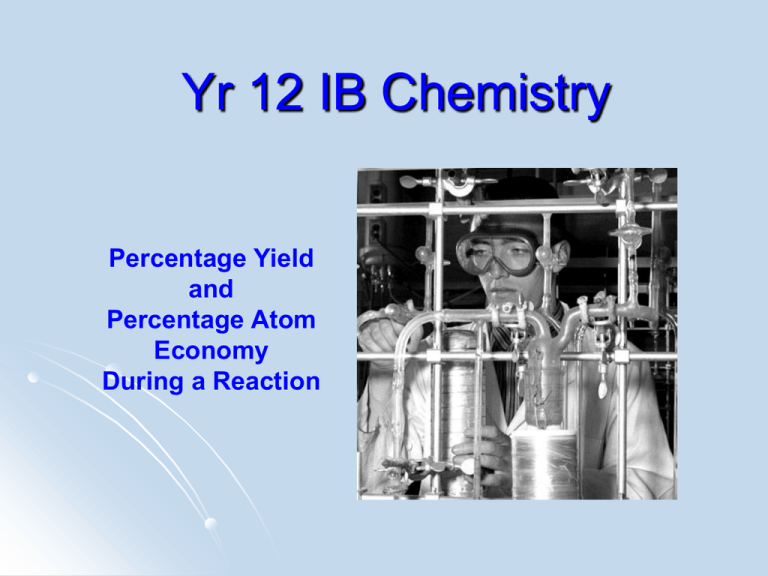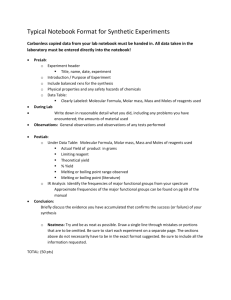percentage yield and atom economy
advertisement

Yr 12 IB Chemistry Percentage Yield and Percentage Atom Economy During a Reaction Percentage Yield During a Reaction Actual Yield in Grams Produced During an Experiment % Yield = Theoretical Yield (as predicted by reaction equation) in Grams % yield will usually be less than 100% because : 1. The reaction may be incomplete 2. Other reactions may occur 3. Product is lost during separation and purification x 100 Steps to Calculate a Percentage Yield 1. Convert the mass of main reactant to a number of moles using mol = mass/molar mass 2. Calculate the theoretical number of moles of product using the ratio from the balanced equation 3. Calculate the theoretical mass of product using mass = mol x molar mass 4. Calculate the percentage yield using : % Yield = Actual Yield in Grams x 100 Theoretical Yield in Grams N.B. This assumes all other reactants are present in excess, or at least in stoichiometric amounts e.g1 12.0g ethanol (C2H5OH) is reacted to produce 5.3g of ethene (C2H4). Calculate the % yield. 1. Number of moles of ethanol used = 12.0 / 46 = 0.26 2. C2H5OH C2H4 + H2O. Theoretical number of moles of ethene formed = 0.26 since 1:1 reaction 3. Theoretical mass of ethene formed = 0.26 x 28 4. % Yield = = 7.3g 5.3 7.3 x 100 = 72.5% e.g2 8.85 g of sodium hydroxide (NaOH) is reacted to produce 9.45 g of sodium carbonate (Na2CO3). Calculate the % yield. 1. Number of moles of NaOH used = 8.85 / (23.0 + 16.0 + 1.0) = 0.221 2. 2NaOH + CO2 Na2CO3 + H2O. Theoretical number of moles of Na2CO3 formed = 0.221/2 (since 2:1 reaction ) = 0.111 3. Theoretical mass of Na2CO3 formed = 0.111 x (2(23)+12+3(16)) = 11.73g 4. % Yield = 9.45 11.73 x 100 = 80.6% % Atom Economy A measure of the percentage of the starting materials that actually ends up in the useful products. The greater the % atom economy of a reaction, the more 'efficient' or 'economic' it is likely to be, To calculate the % Atom Economy : 1. Write the balanced equation for the reaction 2. Calculate the total mass of the reactants for the numbers of moles in the reaction equation 3. Calculate the total mass of the “desired product” for the numbers of moles in the reaction equation 4. massproduct x 100 % Atom Economy = massreactants Note : reactions involving only the production of a SINGLE PRODUCT will have 100% atom economy e.g. H2 + Cl2 2HCl C2H4 + H2 C2H6 N2 + 3H2 2NH3 Example 1 The equation for the production of lime (CaO) from limestone (CaCO3) is: CaCO3 CaO + CO2 Calculate the % atom economy of this process. Mreactants = 40.1 + 12.0 + 3(16.0) = 100.1 g Mproduct = 40.1 + 16.0 = 56.1 g % Atom Economy = 56.1 x 100 100.1 = 56.0% Example 2 The equations for the extraction of titanium from titanium(IV) oxide are: TiO2 + C + 2Cl2 TiCl4 + CO2 TiCl4 + 2Mg Ti + 2MgCl2 Calculate the % atom economy of the overall process. Combining 2 equations for an overall equation gives: TiO2 + C + 2Cl2 + TiCl4 + 2Mg TiCl4 + CO2 + Ti + 2MgCl2 Mreactants = 47.9 + 2(16.0) + 12.0 + 2(2 x 35.5) + 2(24.3) = 282.5 g Mproduct = 47.9 g % Atom Economy = 47.9 x 100 282.5 = 17.0% Such a low % atom economy is typical of a MULTISTAGE process. Example 3 The equation for the extraction of copper from copper sulphide is: CuS + O2 Cu + SO2 1 Calculate the % atom economy of the reaction. 2 If 9.60 tonnes of copper sulphide produce 4.80 tonnes of copper, calculate the % yield 1 CuS + O2 Cu + SO2 Mreactants = (63.5 + 32.1) + (2 x 16) = 127.6 g Mproduct = 63.5 g % Atom Economy = 63.5 x 100 = 127.6 49.8% 2. Theoretically, in excess oxygen, one mole CuS one mole Cu i.e. (63.5 + 32.1) g CuS 63.5 g Cu i.e. 95.6 g CuS 63.5 g Cu i.e. 1.0 g CuS 63.5 / 95.6 = 0.664 g Cu i.e. 1.0 tonnes CuS 0.664 tonnes Cu i.e. 9.60 tonnes CuS 9.60 x 0.664 = 6.38 tonnes Cu % Yield Cu = 4.80 x 100 6.38 = 75.2% The End





